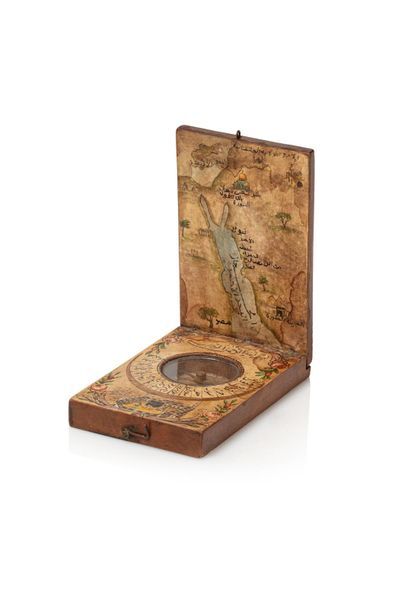Indicateur Qibla et cadran solaire signé signé Zahîr Kashânî, daté 1079 / 1668-79. de forme carrée en bois laqué, lignes des heures peintes, noms de lieu, directions cardinales, ligne méridienne, signé " 'Amal Zahîr Kashânî" et daté. Manquent l'aiguille et l'instrument formant cadran. Cet instrument permettait aux utilisateurs de trouver la qibla (direction de la Mecque) où qu’ils se trouvent. La première étape consistait à localiser nord-sud en plaçant l'instrument sur une surface plane et en permettant à l'aiguille de trouver le nord magnétique. La planche était ensuite tournée. Les inscriptions sur le bois agiraient comme une forme de carte. Selon l'endroit où se trouve l'utilisateur, ils peuvent se diriger vers la Mecque et localiser la direction de la qibla. Conservé dans son étui à rabat en maroquin rouge. (Soulèvement du papier laqué dû à l'humidité). Iran, 1668-69. 19 x 19 cm Les exemples survivants de tels instruments en bois laqué sont rares. Pour un exemple similaire, voir Venetia Porter et Mariam Rosser-Owen, Métallurgie et culture matérielle dans le monde islamique, Londres, 2012, fig.74, p.110. A Qibla indicator and sundial signed Zahîr Kashânî, Iran, dated 1079AH/1668-69AD squarred lacquered wooden body, painted hour lines, place names, cardinal directions, meridian line, signed and dated. This instrument allowed users to find the qibla (the direction of Mecca) from wherever they were. The first step was to locate north-south by placing the instrument on a flat surface and allowing the needle to find magnetic north. The board was then rotated. The inscriptions on the wood would act as a form of map. Depending on where the user was located, they could direct themselves towards Mecca and locate the direction of the qibla. Surviving examples of such instruments in lacquered wood are rare. For a similar example see Venetia Porter and Mariam Rosser-Owen, Metalwork and Material Culture in the Islamic World, London, 2012, fig.74, p.110.
Indicateur Qibla et cadran solaire signé signé Zahîr Kashânî, daté 1079 / 1668-79. de forme carrée en bois laqué, lignes des heures peintes, noms de lieu, directions cardinales, ligne méridienne, signé " 'Amal Zahîr Kashânî" et daté. Manquent l'aiguille et l'instrument formant cadran. Cet instrument permettait aux utilisateurs de trouver la qibla (direction de la Mecque) où qu’ils se trouvent. La première étape consistait à localiser nord-sud en plaçant l'instrument sur une surface plane et en permettant à l'aiguille de trouver le nord magnétique. La planche était ensuite tournée. Les inscriptions sur le bois agiraient comme une forme de carte. Selon l'endroit où se trouve l'utilisateur, ils peuvent se diriger vers la Mecque et localiser la direction de la qibla. Conservé dans son étui à rabat en maroquin rouge. (Soulèvement du papier laqué dû à l'humidité). Iran, 1668-69. 19 x 19 cm Les exemples survivants de tels instruments en bois laqué sont rares. Pour un exemple similaire, voir Venetia Porter et Mariam Rosser-Owen, Métallurgie et culture matérielle dans le monde islamique, Londres, 2012, fig.74, p.110. A Qibla indicator and sundial signed Zahîr Kashânî, Iran, dated 1079AH/1668-69AD squarred lacquered wooden body, painted hour lines, place names, cardinal directions, meridian line, signed and dated. This instrument allowed users to find the qibla (the direction of Mecca) from wherever they were. The first step was to locate north-south by placing the instrument on a flat surface and allowing the needle to find magnetic north. The board was then rotated. The inscriptions on the wood would act as a form of map. Depending on where the user was located, they could direct themselves towards Mecca and locate the direction of the qibla. Surviving examples of such instruments in lacquered wood are rare. For a similar example see Venetia Porter and Mariam Rosser-Owen, Metalwork and Material Culture in the Islamic World, London, 2012, fig.74, p.110.














Try LotSearch and its premium features for 7 days - without any costs!
Be notified automatically about new items in upcoming auctions.
Create an alert